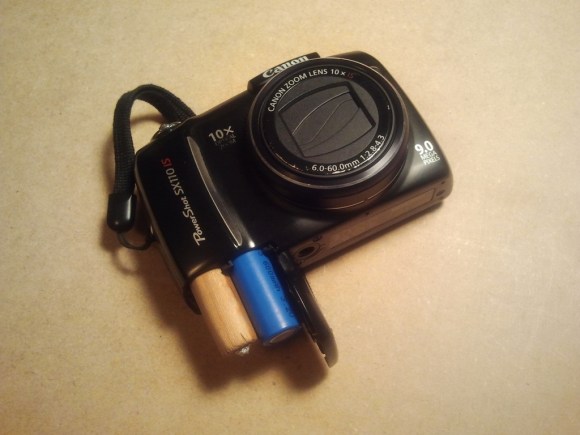
We agree with [Zapmaker] that Canon cameras chew through nickel metal hydride batteries. But we’re not going to use Alkaline because we think it’s wasteful. His solution is to use a battery that has a higher voltage rating. What you see here is a single lithium iron phosphate cell paired with a dummy cell to increase life between charges.
The reason that NiMH batteries don’t last very long is that they’re only rated at 2.4V. It won’t take long for that voltage to drop below the camera’s cutoff threshold since they didn’t start very high to begin with. But a single LiFePO4 cell has the same form-factor but produces 3.2V and maintains voltage well through it’s discharge cycle.
The size is right, but using one cell won’t work by itself. He built a filler for the other slot which is just a wood dowel with a screw all the way through it. The point was ground down and a bit of foil added to ensure a proper connection. We’d be interested to hear back about how this performs over the long term.
















I have owned a sx-120 and a sx-130,
have always used rechargeables in them
The 130 was a battery hog compared to the 120.
The cells were always disturbingly hot when removed from the 130.
I’ve found the “super zinc” cells have around
1.6~7 ocv when fresh charged and gave faster flash cycle times.
the drawback though is that the cameras
aren’t calibarted for the voltage curve of the super z’s and when the camera still thinks
that there is useful charge in the cell,
it’s really past the “knee point” in it’s delivery curve.
leads to some corrupted video files if you don’t
stop the camera and change out the cells
at the first blink of low battery warning.
on a side note , both of the cameras have heat buildup problems if you are walking around
with them on while trying to stay prepared for
candid shooting.
the sx-130 had a limit of about 10 min imposed
on it’s best quality video recording,
But mine rarely could get past 7~8 mins before the camera stopped itself (wasn’t a memory space thing had enough card size and tried different brands and class cards) could just feel the camera getting really warm and know that it’s about to stop video.
You don’t need to press the Enter key every time you reach the edge of the textbox. Just let it wrap around.
p.s. I had all those issues regardless of the battery type used primary’s or ni-cads or the super zincs.
(sorry, but NOT going to permit more scripting just to edit a remark )
Please, Hackaday, don’t go down the scripting
hell hole.
This. I would guess that the majority of people who regularly view this site are smart enough to be running something like Ghostery or NoScript.
Ghostery here. HaD is one of the sites I visit that uses the most trackers : currently nine.
You can be ready made dummy cells for just this purpose. Just search for dummy AA on ebay or wherever and you’ll find it.
Instead of wasting space, why not just have a second battery and run it in parallel? Obviously just requires some wiring between the batteries to make sure the right terminals are connected to the right ends, but easy enough
noscript ! cant live without it
Nickel-Zinc rechargeable batteries didn’t really take off in the market, but the NiZn chemistry is something like 1.6 volts, so they work really well for digital cameras and other applications that need more than 1.2v, if you can find them. (I had four of them that came with a charger, but was never able to find any sold separately, and could only find AA, not AAA.)
NiMh cells are 1.2V, not 2.4V.
But when you pair them up it is 2.4v
There are also metal cased dummy batteries – I had 2 delivered from an ebay seller by mistake, and I think dealextreme sell them. I’ve used 2 of those and a Li-Ion AA rechargeable to run a 3AA headtorch (3.7V or thereabouts), the same approach would work here.
On a side note, the SX110 was just an awful camera. I’ve had many Canons, from film to DSLR to compact digital, and this is the only one to disappoint. The best hack I found was to lend it to a friend who dropped it and killed it.